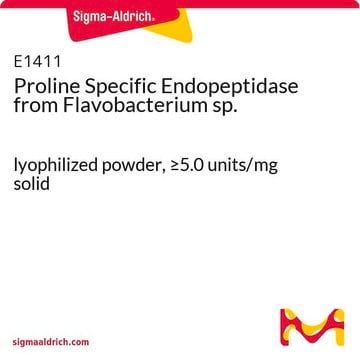P2289
Endoproteinase Lys-C from Lysobacter enzymogenes
lyophilized powder
Sign Into View Organizational & Contract Pricing
All Photos(1)
About This Item
CAS Number:
EC Number:
MDL number:
UNSPSC Code:
12352204
Recommended Products
form
lyophilized powder
Quality Level
analyte chemical class(es)
amino acids
packaging
vial of ≥3.0 units
storage temp.
2-8°C
Looking for similar products? Visit Product Comparison Guide
General description
Endoproteinase Lys-C is an enzyme that preferentially cleaves at the carboxyl side of lysine residues.
Application
Endoproteinase Lys-C from Lysobacter enzymogenes is useful in the determination of primary structures of proteins. It has been used in a study to investigate the evidence for trisulfide bonds in a recombinant variant of a human IgG2 monoclonal antibody.
Endoproteinase Lys-C has been used for the digestion monoclonal antibodies for disulfide bond assignment.
Biochem/physiol Actions
Endoproteinase Lys-C inactivates the enzyme inositol monophosphatase by cleaving it at a single site directly after Lys 36.
Unit Definition
One unit will hydrolyze 1.0 μmole of N-p-tosyl-Gly-Pro-Lys p-nitroanilide per min at pH 7.7 at 25 °C.
Signal Word
Danger
Hazard Statements
Precautionary Statements
Hazard Classifications
Eye Irrit. 2 - Resp. Sens. 1 - Skin Irrit. 2 - Skin Sens. 1 - STOT SE 3
Target Organs
Respiratory system
Storage Class Code
11 - Combustible Solids
WGK
WGK 3
Flash Point(F)
Not applicable
Flash Point(C)
Not applicable
Personal Protective Equipment
dust mask type N95 (US), Eyeshields, Gloves
Certificates of Analysis (COA)
Search for Certificates of Analysis (COA) by entering the products Lot/Batch Number. Lot and Batch Numbers can be found on a product’s label following the words ‘Lot’ or ‘Batch’.
Already Own This Product?
Find documentation for the products that you have recently purchased in the Document Library.
Hiromi Ito et al.
Journal of chromatography. B, Analytical technologies in the biomedical and life sciences, 806(1), 11-17 (2004-05-20)
Formation of covalently bound protein adducts with 2-arylpropionic acids (2-APAs) has been proposed as a possible explanation for hypersensitivity and toxic responses to chiral carboxylic acid drugs. To identify the cellular proteins chemically modified with optically active (S)-ibuprofen, we generate
The effects of substrates, products and other ligands on the susceptibility ofinositol monophosphatase to proteolysis by endoprotease lys-C.
Gee NS
FEBS Journal, 284, 95-97 (1991)
Wei Zhang et al.
Analytical biochemistry, 311(1), 1-9 (2002-11-21)
Recombinant monoclonal antibodies (mAbs) are an emerging therapeutic area. However, there are few reports on disulfide bond assignment of recombinant mAbs. This work describes the complete disulfide bond assignment of a recombinant immunoglobulin G4 (IgG4) mAb. N-ethylmaleimide (NEM) was used
J G Jacobs et al.
Journal of virology, 85(23), 12537-12546 (2011-09-16)
Classical scrapie is a prion disease in sheep and goats. In sheep, susceptibility to disease is genetically influenced by single amino acid substitutions. Genetic breeding programs aimed at enrichment of arginine-171 (171R) prion protein (PrP), the so-called ARR allele, in
Pavlo Pristatsky et al.
Analytical chemistry, 81(15), 6148-6155 (2009-07-14)
The hinge region of human IgG2 contains four cysteine residues involved in disulfide linkages between the heavy chains, as well as the heavy and light chains. These linkages provide the fundamental framework of three distinct IgG2 disulfide isoforms recently described.
Our team of scientists has experience in all areas of research including Life Science, Material Science, Chemical Synthesis, Chromatography, Analytical and many others.
Contact Technical Service










